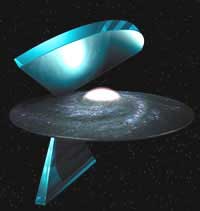Neutrino weighed up

Astronomers surveyed regions outside our Galaxy to estimate neutrino’s mass. <br>© R. Smith <br>
Astronomers use galaxies to reckon a subatomic particle’s mass.
By mapping hundreds of thousands of galaxies, astronomers have estimated the mass of the neutrino. They have also calculated the contribution that this mysterious subatomic particle makes to the total mass of the Universe.
The neutrino weighs no more than one-billionth of the mass of a hydrogen atom, Ofer Lahav of the University of Cambridge told the annual UK National Astronomy Meeting in Bristol today. Yet despite being so small, neutrinos could account for a maximum of about 20% of the mass of the entire Universe.
Lahav and his colleagues deduced the influence of neutrinos by comparing a three-dimensional map of the Universe with the predictions of theoretical physics. “We can use a huge chunk of the Universe to constrain the mass of a tiny particle,” says Lahav.
Small but influential
Neutrinos are unimaginably tiny, carry no electrical charge and can pass through planets unperturbed. But their abundance makes them potentially major players in the Universe.
For a long time it was thought that neutrinos had no mass at all. Recent astronomical observations have suggested that they do, but working out the exact figure “is probably one of the hardest questions [in physics]”, says theoretical physicist Stephen King of the University of Southampton, UK.
The new estimate “sounds like a reasonable number”, King adds. It broadly agrees with, although does not confirm, other figures produced from studies of radioactive decay earlier this year.
One-billionth of a hydrogen atom is towards the lower end of current estimates. If this value stands up, it shows that neutrinos do not exert enough gravitational tug to have much influence over the evolution of the visible Universe, says King. “It’s saying that neutrinos can’t play an important part in galaxy formation.”
Revealing wrinkles
Lahav and his colleagues’ conclusion is based on gauging the lumpiness of the Universe. Tiny wrinkles in the Big Bang led to matter forming into gigantic clumps – galaxies, and clusters of galaxies – as the Universe aged.
Yet only about 5% the Universe’s mass is in a visible form. The rest is in a variety of substances known as dark matter, of which neutrinos are one component.
Dark matter is betrayed by its influence on what we can see. Neutrinos, which whizz through space at close to the speed of light, smooth the Universe out by redistributing mass. The heavier neutrinos are, the less clumping we should see in today’s Universe.
Lahav’s team used a three-dimensional map of 160,000 galaxies that they constructed as part of an Anglo-Australian team. They worked out the mass of the neutrino that best fitted the spread of galaxies they saw.
Media Contact
All latest news from the category: Physics and Astronomy
This area deals with the fundamental laws and building blocks of nature and how they interact, the properties and the behavior of matter, and research into space and time and their structures.
innovations-report provides in-depth reports and articles on subjects such as astrophysics, laser technologies, nuclear, quantum, particle and solid-state physics, nanotechnologies, planetary research and findings (Mars, Venus) and developments related to the Hubble Telescope.
Newest articles

First-of-its-kind study uses remote sensing to monitor plastic debris in rivers and lakes
Remote sensing creates a cost-effective solution to monitoring plastic pollution. A first-of-its-kind study from researchers at the University of Minnesota Twin Cities shows how remote sensing can help monitor and…

Laser-based artificial neuron mimics nerve cell functions at lightning speed
With a processing speed a billion times faster than nature, chip-based laser neuron could help advance AI tasks such as pattern recognition and sequence prediction. Researchers have developed a laser-based…

Optimising the processing of plastic waste
Just one look in the yellow bin reveals a colourful jumble of different types of plastic. However, the purer and more uniform plastic waste is, the easier it is to…


